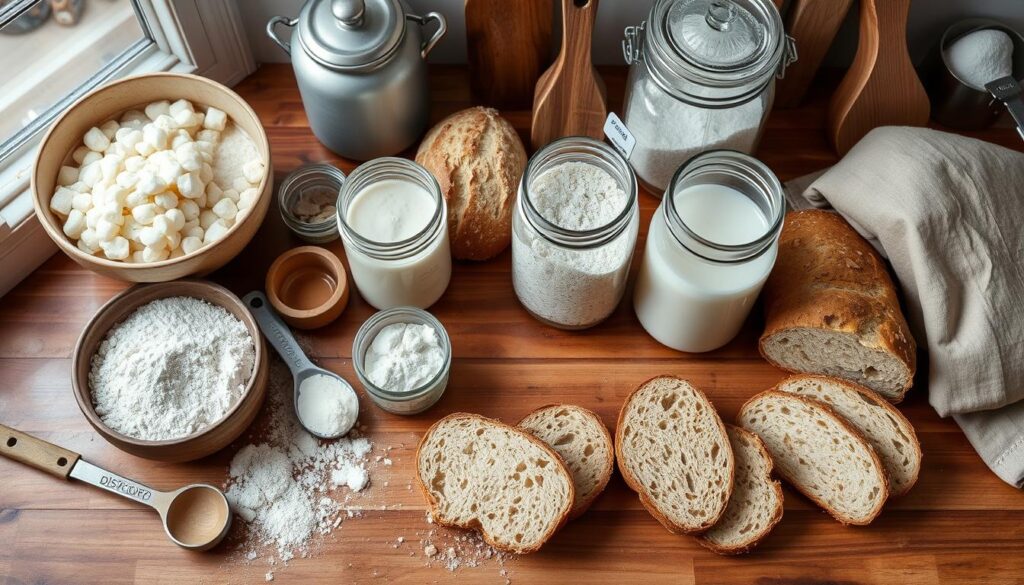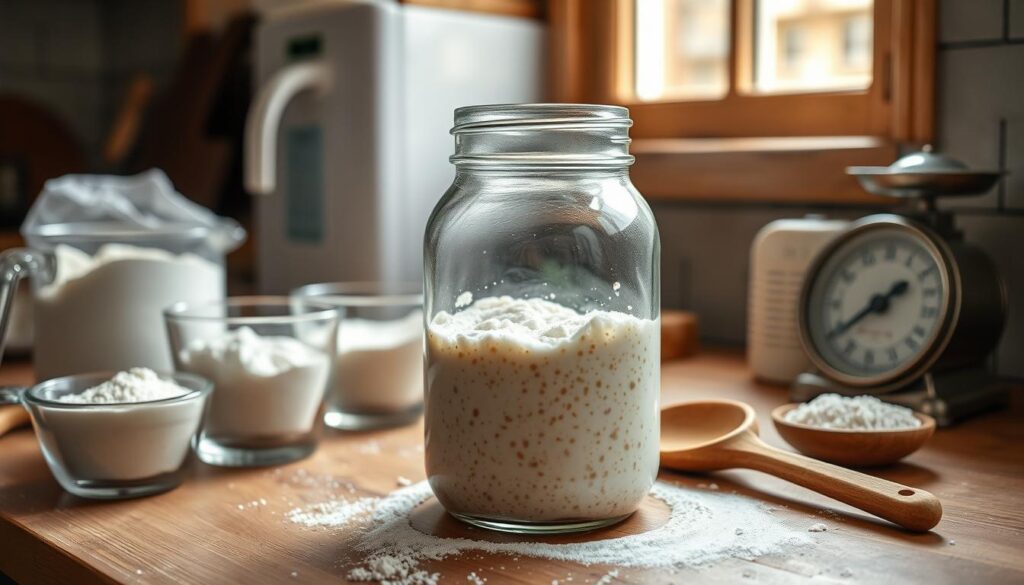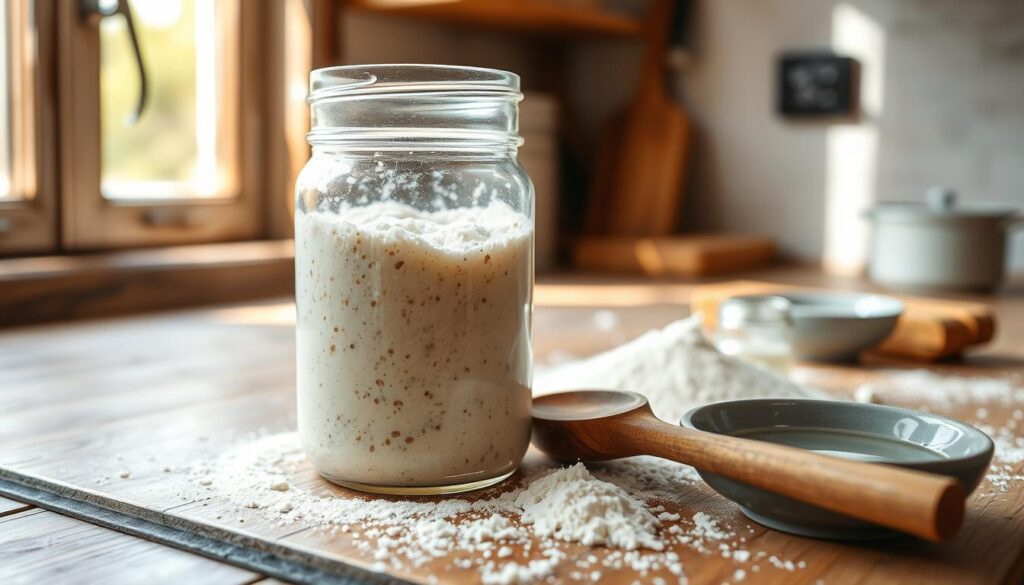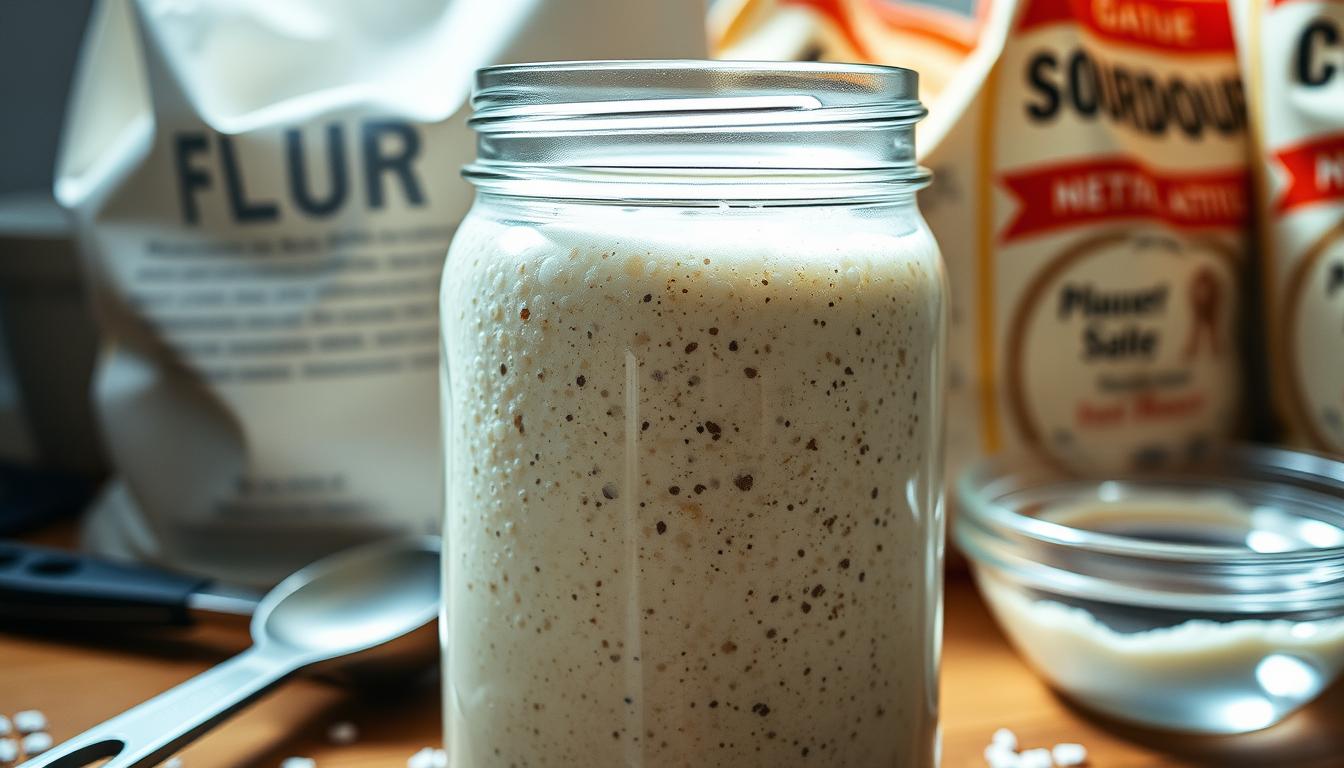When I first started my sourdough journey, I wondered: Do you have to discard part of your sourdough starter every time you feed it?”
The idea of removing some of the starter during feeding was confusing. However, I quickly learned that discarding is an essential part of maintaining a healthy sourdough starter.
Each time you feed your sourdough starter, you may need to discard part of it. This process not only keeps the starter from growing too large but also ensures it stays active and balanced. Without discarding, the starter can become sluggish, impacting the fermentation process.
Do you have to discard sourdough starter every time you feed it? The short answer is yes, but there’s more to it. Discarding controls the starter’s growth and maintains its unique flavor profile. Plus, the discarded starter doesn’t have to go to waste—it’s perfect for creative recipes like pancakes, waffles, and crackers.
By understanding why you have to discard part of your sourdough starter, you’ll feel more confident about maintaining this living culture. Regular feeding and occasional discarding are essential for a strong, active sourdough starter.
Key Takeaways
- Sourdough maintenance involves regular feedings and occasional removal of excess starter.
- Removing part of the starter supports a healthy and balanced fermentation process.
- Repurposing the removed portion prevents waste and opens up creative recipe options.
- Understanding the feeding cycle simplifies sourdough care.
- Consistency is key to maintaining a strong, active sourdough culture.
Understanding Sourdough Discard

Sourdough baking has a special process that might confuse new bakers. When you take care of a sourdough starter, you’ll learn about sourdough discard. It’s key to keeping your starter healthy and active.
What is Sourdough Discard?
Sourdough discard is the part of your starter you remove before adding fresh flour and water. It’s like a routine check-up for your sourdough culture. This step helps control the starter’s growth and keeps it working well.
- Prevents overgrowth of wild yeasts and bacteria
- Maintains the right balance of nutrients
- Keeps your starter at a manageable size
Why Does Discard Happen?
Your sourdough starter grows fast during fermentation. If you don’t discard, it will outgrow its container and become unpredictable. Regular discard keeps the starter’s strength and consistency in check.
“Discarding is not waste – it’s a strategic part of sourdough maintenance.” – Professional Baker’s Insight
Can You Use Discard in Sourdough Recipes?
Yes, you can! Sourdough discard is great for many recipes. You can make pancakes, crackers, pizza crusts, and quick breads with it. It turns potential waste into tasty treats.
- Pancakes
- Crackers
- Flatbreads
- Muffins
Using discard opens up a world of creative baking. It turns a routine task into a fun culinary journey.
The Feeding Process of Sourdough
Sourdough feeding is key to keeping your starter alive and active. It’s what makes your bread tangy and delicious. Learning about this process can change your baking game.

Feeding your sourdough starter is like caring for a tiny ecosystem. It’s home to wild yeasts and bacteria. They need regular care to stay healthy and active.
What Happens During Feeding?
When you feed your sourdough starter, you add fresh flour and water. This gives:
- New nutrients for growth
- A fresh environment for fermentation
- Just the right acidity
How to Feed Your Sourdough Starter
Here’s how to keep your starter in top shape:
- Measure your starter
- Throw away some of the old starter
- Add equal parts flour and water
- Mix well
“A well-fed starter is the heart of exceptional sourdough bread” – Professional Baker’s Wisdom
How often you feed your starter depends on where it’s stored and how you use it. At room temperature, it needs daily feeding. In the fridge, it’s okay to feed it less often.
| Storage Location | Feeding Frequency | Starter Activity |
|---|---|---|
| Room Temperature | Daily | High |
| Refrigerator | Weekly | Low |
Feeding your sourdough starter regularly makes it strong and flavorful. It’s ready to take your baking to the next level.
When Discarding is Necessary
Keeping your sourdough starter healthy is all about balance. Knowing when to discard it is key to a thriving culture.

The Role of Balance in Sourdough
Right balance in your starter stops yeast and bacteria from getting too crowded. Do You Have to Discard Every Time You Feed Sourdough? Not always. But, discarding wisely helps manage the population and nutrients.
- Prevents excessive acidity
- Manages microbial population
- Ensures consistent fermentation
Identifying When to Discard
Knowing when to discard your starter involves watching for certain signs.
| Indicator | Action Needed |
|---|---|
| Excessive growth | Partial discard recommended |
| Liquid layer (hooch) | Stir or discard some starter |
| Weak fermentation | Complete reset might be necessary |
“A healthy starter is about quality, not quantity” – Sourdough Experts
Your sourdough starter’s health is all about watching and acting fast. By knowing when and how to discard, you keep your starter lively and ready for baking.
Alternatives to Discarding Every Time
Sourdough baking fans know that discard doesn’t have to go to waste. Instead of throwing away extra starter, you can make tasty dishes. This saves money and cuts down on kitchen waste.
Your sourdough discard is very versatile. It can make many recipes better than just bread. Home bakers find new ways to use this flavorful mix in daily meals.
Delicious Sourdough Recipes Using Discard
- Pancakes and waffles with tangy flavor
- Savory crackers with crisp texture
- Fluffy biscuits with enhanced taste
- Tender pizza crusts
- Hearty muffins and quick breads
Incorporating Discard into Meals
Sourdough discard can add depth to many dishes. It makes your cooking more complex. Here are some creative ways to use your starter:
- Mix discard into scrambled eggs
- Use as a base for savory pancakes
- Create flavorful coating for fried foods
- Blend into salad dressings
“Waste not, want not” takes on new meaning with sourdough recipes that transform discard into culinary treasures.
| Discard Recipe | Preparation Time | Difficulty Level |
|---|---|---|
| Sourdough Crackers | 30 minutes | Easy |
| Discard Pancakes | 20 minutes | Very Easy |
| Savory Muffins | 45 minutes | Moderate |
With these sourdough recipes, discard is no longer waste. Try new things, have fun, and see what your sourdough starter can do!
Common Misconceptions About Discard
Sourdough baking can be confusing, especially about discarding starter. Many home bakers worry about wasting ingredients. They wonder: Do you have to discard every time you feed sourdough? Let’s clear up some common myths and share the truth about sourdough maintenance.
Debunking Discard Myths
You don’t always have to discard your sourdough starter during every feeding. The key is understanding your starter’s needs and managing its growth well.
- Myth: Discarding is mandatory for every feeding
- Reality: Controlled feeding can minimize waste
- Goal: Maintain a healthy, active sourdough culture
Understanding Discard’s Flavor Impact
The discard process is key in developing your sourdough’s unique flavor. Proper management of your starter can enhance its taste and performance.
| Discard Strategy | Flavor Outcome |
|---|---|
| Frequent Small Discards | Milder, More Consistent Flavor |
| Infrequent Large Discards | Stronger, More Tangy Taste |
“The art of sourdough is about balance, not waste.” – Professional Baker’s Insight
When baking sourdough, remember that flexibility is key. You can reduce discard by adjusting your feeding schedule. Keep only the starter you need, and explore creative recipes that use excess starter.
Frequency of Feedings
Keeping your sourdough starter healthy means regular feeding. How often you feed it depends on a few important factors. These factors affect your starter’s health and how well it works.
There’s no one right way to feed your starter. The environment and conditions around it can change how often you need to feed it.
Understanding Feeding Frequency
Feeding your starter regularly keeps the yeast and bacteria alive. The main things to think about when deciding how often to feed are:
- Room temperature
- Starter activity level
- Your baking schedule
- Storage method
Temperature-Based Feeding Guidelines
Temperature is key in taking care of your sourdough starter. Here’s a simple guide for feeding times:
| Temperature Range | Feeding Frequency | Starter Behavior |
|---|---|---|
| 60-70°F | Every 24 hours | Slower fermentation |
| 70-80°F | Every 12-18 hours | Optimal activity |
| 80-90°F | Every 8-12 hours | Rapid fermentation |
*Pro tip: Watch your starter’s rise and fall to determine its peak activity and adjust feeding times accordingly.*
If you’re not baking often, you can put your starter in the fridge. This slows down fermentation and means you only need to feed it once a week.
The Importance of Starter Hydration
Keeping your sourdough starter hydrated is key to its health. The right amount of water affects how it ferments, tastes, and performs in baking. Learning to manage hydration can greatly improve your sourdough starter care.
Understanding Hydration Ratios
The hydration ratio is the water to flour mix in your starter. A common ratio is equal parts water and flour. Changing this ratio can alter your starter’s texture and taste.
- Low hydration (50-60%): Thick, stiff consistency
- Standard hydration (100%): Smooth, pancake batter-like texture
- High hydration (120-150%): Very liquid, runny consistency
Adjusting Hydration Without Discarding
You can change your starter’s hydration without wasting it. The trick is to do it slowly during feeding times. Start by adding small amounts of water or flour to make gradual changes.
“Patience is the secret to perfect starter maintenance” – Artisan Bakers’ Wisdom
| Hydration Level | Starter Characteristics | Best Used For |
|---|---|---|
| Low Hydration | Dense, slow fermentation | Rustic, dense breads |
| Standard Hydration | Balanced, predictable rise | Most bread recipes |
| High Hydration | Quick fermentation, airy | Open crumb, lighter breads |
Trying different hydration levels lets you tailor your starter for various baking needs. Remember, keeping a consistent temperature and feeding schedule is also crucial for your starter’s health.
Troubleshooting Your Sourdough Starter
Sourdough starter care can be tough, even for experts. It’s a living thing that needs careful care. Knowing how to spot and fix problems is key for great sourdough.
Recognizing a Healthy Starter
A strong sourdough starter shows a few important signs:
- It rises and falls after feeding
- It smells nice, a bit tangy
- There are bubbles all over
- It gets elastic and doubles in 4-8 hours
“A healthy starter is like a well-tuned instrument – it responds predictably and produces beautiful results.” – Professional Baker
Addressing a Weak Starter
If your starter is slow, try these tips to boost its strength:
- Look at your feeding schedule
- Make sure your water and flour are good
- Keep the temperature steady
- Check if your starter is too dry
In sourdough baking, patience and regular care are vital. If your starter is weak, don’t worry. Most problems can be fixed with a bit of patience and the right adjustments to your care routine.
Reviving Your Starter
Pro tip: Keep only a little starter and feed it the same time every day. Throw away the extra and use fresh, quality flour and water.
Creative Uses for Sourdough Discard
Sourdough discard doesn’t have to be thrown away. It can add flavor to your cooking and baking. With a little creativity, it can become a key ingredient in many dishes, reducing waste and enhancing taste.
Baking Beyond Bread
Use your sourdough discard to make many baked goods better. Try adding it to:
- Pancakes and waffles
- Muffins and quick breads
- Crackers and flatbreads
- Pizza dough
Culinary Adventures with Sourdough Recipes
Sourdough discard is great for more than just baking. Here are some creative ways to use it:
- Savory Crackers: Mix it with herbs and cheese for tasty snacks
- Coating for Fried Foods: Use it as a tangy batter for chicken or veggies
- Flavor Enhancer: Add it to sauces, dressings, and marinades
“Sourdough discard is liquid gold in the kitchen – don’t let it go to waste!”
By thinking outside the box with sourdough discard, you’ll find a world of tasty possibilities. It’s more than just bread.
Maintaining a Healthy Sourdough Starter Through Regular Feeding
Learning to care for a sourdough starter is an art. It needs patience, attention, and regular care. Your starter is a living mix of wild yeasts and bacteria. It must be nurtured to stay lively and active.
To keep your starter healthy, follow some key practices. These will help your starter stay strong and active. Let’s look at the main ways to keep your sourdough starter in top shape.
Why Removing Excess Starter Is Essential
Good sourdough starter care begins with knowing its needs. Here are important tips for keeping your starter healthy:
- Use consistent, high-quality flour for feeding
- Maintain a regular feeding schedule
- Keep your starter at a stable temperature
- Use clean utensils to prevent contamination
“A well-maintained starter is the foundation of delicious sourdough bread.” – Professional Baker
How Regular Feeding Supports Fermentation
How you store your starter is key. You have different options based on how often you bake:
- Counter Storage: For those who bake often and feed daily
- Refrigerator Storage: Best for those who bake less often
- Dried Starter Preservation: A long-term backup option
Your sourdough starter needs constant care and attention. By following these tips, you’ll have a thriving starter. It will make delicious bread for you.
Conclusion: The Choice is Yours
Understanding sourdough bread is all about finding the right balance. Your sourdough journey is personal, with no one-size-fits-all approach. You don’t always have to discard every time you feed it.
It’s about finding what works for you, your kitchen, and your baking dreams. Try out different methods to create a routine that saves waste and makes great bread. Every starter is unique, so what works for one might not work for another.
Managing your sourdough discard can lead to new culinary adventures. You can turn what seems like waste into tasty treats like pancakes or crackers. Your sourdough journey is about exploring, adapting, and enjoying the process of making something special.
Your Sourdough, Your Rules
Successful sourdough baking is about knowing your starter and trusting your instincts. Be confident, stay curious, and be ready to change your approach. Whether you discard a little or a lot, the most important thing is your love for baking.

